
Tuesday, February 28, 2006
Web blitz [28-Feb-05]

Noah sets sail for the moon
A number of weeks ago I blogged about how a doomsday seed bank is going to be built in Norway. It now appears, however, that some believe an off-planet repository would be an even better idea.
Bernard Foing is one of these people. He is the principal scientist for the European Space Agency’s SMART-1, a spacecraft that is currently in orbit around the moon, and he is also the director of the International Lunar Exploration Working Group. Fearing a terrible catastrophe, either man-made or natural, Foing would like to see a genetic bank created on the moon to preserve the Earth's biological heritage.
But Foing is hoping for more than just a DNA bank on the moon. He argues that life is more than the expression of information coded in DNA; he believes that actual living organisms need to be maintained in order to express the full range of life. Consequently, he envisions a "lunar lifeboat" that has a facility to grow plants and microorganisms, and, for more advanced life forms, to incubate eggs and develop embryos.
His idea is something right out of Silent Running. In order to maintain the biosphere on the moon, Foing envisions a fleet of robotic gardeners who are controlled remotely from Earth. These robots would tend to flowers and microorganisms. An offshoot of this work, says Foing, is that it would show us how living organisms are able to adapt to different environments prior to a move to a bigger and more extensive facility.
Eventually, humans would take the place of the robots, performing much more sophisticated work involving genomics and cloning.
Foing's idea is intriguing, but a number of issues come to mind.
To date, all self-contained artificial biosphere projects here on Earth have failed. If we can't create an enclosed biosphere on the Earth, then there's no way in hell we can create one on the moon. First thing's first.
Second, the conditions on the moon to support actual living organisms may be more difficult than Foing believes. Even if a perfect biosphere can be created, there are issues of radioactivity, altered electromagnetism (which may or may not have any effect on life), and weaker gravity. We may find that organisms will have a particularly hard time living in the altered conditions of the moon.
I'm also dubious that actual living organisms need to be maintained on the moon. I think a gene bank which contains all the DNA information may suffice. Eventually, a molecular assembler will be able to manufacture any organism from its DNA, making the need for an actual biological forbearer unnecessary (if, however, we suffer some sort of disaster before the advent of molecular assembly nanotechnology, then we may be out of luck. But I'm thinking that if we have an apocalyptic scale event pre-nano era, we're probably S.O.L. anyway). As for the preservation of viable ecosystems, I'd have to think that computer modelling will do the trick and advise us of the necessary variables.
This being said, however, the exercise of maintaining live organisms on the moon may prove fruitful as an experimental precursor to terraforming Mars. It'll give us a good idea of the challenges we may face in bringing organisms to life on another world.
Tags: Disasters, Gene Banks, Catastrophe, Existential Risks, biosphere.
Bernard Foing is one of these people. He is the principal scientist for the European Space Agency’s SMART-1, a spacecraft that is currently in orbit around the moon, and he is also the director of the International Lunar Exploration Working Group. Fearing a terrible catastrophe, either man-made or natural, Foing would like to see a genetic bank created on the moon to preserve the Earth's biological heritage.
But Foing is hoping for more than just a DNA bank on the moon. He argues that life is more than the expression of information coded in DNA; he believes that actual living organisms need to be maintained in order to express the full range of life. Consequently, he envisions a "lunar lifeboat" that has a facility to grow plants and microorganisms, and, for more advanced life forms, to incubate eggs and develop embryos.
His idea is something right out of Silent Running. In order to maintain the biosphere on the moon, Foing envisions a fleet of robotic gardeners who are controlled remotely from Earth. These robots would tend to flowers and microorganisms. An offshoot of this work, says Foing, is that it would show us how living organisms are able to adapt to different environments prior to a move to a bigger and more extensive facility.
Eventually, humans would take the place of the robots, performing much more sophisticated work involving genomics and cloning.
Foing's idea is intriguing, but a number of issues come to mind.
To date, all self-contained artificial biosphere projects here on Earth have failed. If we can't create an enclosed biosphere on the Earth, then there's no way in hell we can create one on the moon. First thing's first.
Second, the conditions on the moon to support actual living organisms may be more difficult than Foing believes. Even if a perfect biosphere can be created, there are issues of radioactivity, altered electromagnetism (which may or may not have any effect on life), and weaker gravity. We may find that organisms will have a particularly hard time living in the altered conditions of the moon.
I'm also dubious that actual living organisms need to be maintained on the moon. I think a gene bank which contains all the DNA information may suffice. Eventually, a molecular assembler will be able to manufacture any organism from its DNA, making the need for an actual biological forbearer unnecessary (if, however, we suffer some sort of disaster before the advent of molecular assembly nanotechnology, then we may be out of luck. But I'm thinking that if we have an apocalyptic scale event pre-nano era, we're probably S.O.L. anyway). As for the preservation of viable ecosystems, I'd have to think that computer modelling will do the trick and advise us of the necessary variables.
This being said, however, the exercise of maintaining live organisms on the moon may prove fruitful as an experimental precursor to terraforming Mars. It'll give us a good idea of the challenges we may face in bringing organisms to life on another world.
Tags: Disasters, Gene Banks, Catastrophe, Existential Risks, biosphere.
Sunday, February 26, 2006
Many mangled worlds?
Robin Hanson, an economist, physicist and transhumanist, posited a disturbing hypothesis a few years ago about the Many Worlds interpretation of quantum mechanics and the potential for other worlds to interact with our own.
Recently, New Scientist published an account of Hanson's work that doesn't quite get the gyst of it, suggesting that alternate worlds may interact with our own with disastrous consequences. In the article, "Is Our Universe About to be Mangled?" New Scientist suggests that "our universe may one day be obliterated or assimilated by a larger universe."
For those unfamiliar, the Many Worlds Interpretation (MWI) is one of many multiverse hypotheses in physics and philosophy. It's currently considered a mainstream interpretation along with the Copenhagen and consistent histories interpretations.
The MWI suggests that at every moment the universe branches off into a multitude of sets that are based on probabilities. It's like a copy-and-paste for the universe, but each time the paste button is pressed an entire set of variable universes is spawned. And with each passing moment in those parallel universes, more sets are spawned, and so on.
Hanson, who works out of George Mason University in Fairfax, Virginia, published his thesis about "mangled universes" in 2003 and revised it just last year. In the piece, titled "When Worlds Collide: Mangled Worlds Quantum Mechanics," Hanson doesn't so much describe a scenario in which a universe obliterates another as he is describing an observational selectional process and anthropic process that selects for consciousness-friendly universes.
In other words, as you are copied a near infinite number of times into alternate universes, many of your copies are pasted into untenable universes. Like an unviable fetus in a womb, your copied existence will be miscarried in a universe that can't support it.
"In Everett's many worlds interpretation, quantum measurements are considered to be decoherence events," writes Hanson, "If so, then inexact decoherence may allow large worlds to mangle the memory of observers in small worlds, creating a cutoff in observable world size. Smaller world are mangled and so not observed. If this cutoff is much closer to the median measure size than to the median world size, the distribution of outcomes seen in unmangled worlds follows the Born rule. Thus deviations from exact decoherence may allow the Born rule to be derived via world counting, with a finite number of worlds and no new fundamental physics."
There's a truly Darwinian aspect to this process, but don't worry. You will not be able to observe yourself being mangled by an unviable universe.
Which has me in an odd way thinking about the possibility of quantum immortality. This is the speculation that is derived from the quantum suicide thought experiment. Essentially, this argument suggests that if the many-worlds interpretation of quantum mechanics is correct, then a conscious observer can never cease to exist -- regardless of how improbable their existence is from one moment to the next.
Tags: quantum mechanics, many worlds, quantum immortality.
Recently, New Scientist published an account of Hanson's work that doesn't quite get the gyst of it, suggesting that alternate worlds may interact with our own with disastrous consequences. In the article, "Is Our Universe About to be Mangled?" New Scientist suggests that "our universe may one day be obliterated or assimilated by a larger universe."
For those unfamiliar, the Many Worlds Interpretation (MWI) is one of many multiverse hypotheses in physics and philosophy. It's currently considered a mainstream interpretation along with the Copenhagen and consistent histories interpretations.
The MWI suggests that at every moment the universe branches off into a multitude of sets that are based on probabilities. It's like a copy-and-paste for the universe, but each time the paste button is pressed an entire set of variable universes is spawned. And with each passing moment in those parallel universes, more sets are spawned, and so on.
Hanson, who works out of George Mason University in Fairfax, Virginia, published his thesis about "mangled universes" in 2003 and revised it just last year. In the piece, titled "When Worlds Collide: Mangled Worlds Quantum Mechanics," Hanson doesn't so much describe a scenario in which a universe obliterates another as he is describing an observational selectional process and anthropic process that selects for consciousness-friendly universes.
In other words, as you are copied a near infinite number of times into alternate universes, many of your copies are pasted into untenable universes. Like an unviable fetus in a womb, your copied existence will be miscarried in a universe that can't support it.
"In Everett's many worlds interpretation, quantum measurements are considered to be decoherence events," writes Hanson, "If so, then inexact decoherence may allow large worlds to mangle the memory of observers in small worlds, creating a cutoff in observable world size. Smaller world are mangled and so not observed. If this cutoff is much closer to the median measure size than to the median world size, the distribution of outcomes seen in unmangled worlds follows the Born rule. Thus deviations from exact decoherence may allow the Born rule to be derived via world counting, with a finite number of worlds and no new fundamental physics."
There's a truly Darwinian aspect to this process, but don't worry. You will not be able to observe yourself being mangled by an unviable universe.
Which has me in an odd way thinking about the possibility of quantum immortality. This is the speculation that is derived from the quantum suicide thought experiment. Essentially, this argument suggests that if the many-worlds interpretation of quantum mechanics is correct, then a conscious observer can never cease to exist -- regardless of how improbable their existence is from one moment to the next.
Tags: quantum mechanics, many worlds, quantum immortality.
Appy-polly-loggies! An excellent Clockwork Orange review
 Theodore Dalrymple has written an extremely interesting and insightful review, "Oh, to Be In England: A Prophetic and Violent Masterpiece", of A Clockwork Orange, contrasting Anthony Burgess's novel with Stanley Kubrick's film.
Theodore Dalrymple has written an extremely interesting and insightful review, "Oh, to Be In England: A Prophetic and Violent Masterpiece", of A Clockwork Orange, contrasting Anthony Burgess's novel with Stanley Kubrick's film. From Dalrymple's review:
The author of the book, Anthony Burgess, a polymath who once wrote five novels in a year, came to dislike this particular work intensely, not because of any practical harm to society that the film version of it might have caused but because he did not want to go down in literary history as the author of a book made famous, or notorious, by a movie. Irrespective of the value of his other work, however, A Clockwork Orange remains a novel of immense power. Linguistically inventive, socially prophetic, and philosophically profound, it comes very close to being a work of genius.Memorable quote:
There was me, that is Alex, and my three droogs, that is Pete, Georgie, and Dim, and we sat in the Korova Milkbar trying to make up our rassoodocks what to do with the evening. The Korova milkbar sold milk-plus, milk plus vellocet or synthemesc or drencrom, which is what we were drinking. This would sharpen you up and make you ready for a bit of the old ultra-violence.Tags: reviews, a clockwork orange.
Dennett: Religion is a natural phenomenon
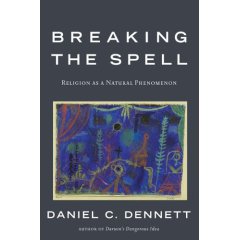 Philosopher Daniel Dennett, author of Consciousness Explained and Freedom Evolves, has penned a new book. Titled Breaking the Spell: Religion as a Natural Phenomenon, Dennett calls for a scientific, rational examination of religion that will lead us to understand what purpose religion serves in our culture.
Philosopher Daniel Dennett, author of Consciousness Explained and Freedom Evolves, has penned a new book. Titled Breaking the Spell: Religion as a Natural Phenomenon, Dennett calls for a scientific, rational examination of religion that will lead us to understand what purpose religion serves in our culture.From Publisher's Weekly:
Much like E.O. Wilson (In Search of Nature), Robert Wright (The Moral Animal), and Richard Dawkins (The Selfish Gene), Dennett explores religion as a cultural phenomenon governed by the processes of evolution and natural selection. Religion survives because it has some kind of beneficial role in human life, yet Dennett argues that it has also played a maleficent role. He elegantly pleads for religions to engage in empirical self-examination to protect future generations from the ignorance so often fostered by religion hiding behind doctrinal smoke screens. Because Dennett offers a tentative proposal for exploring religion as a natural phenomenon, his book is sometimes plagued by generalizations that leave us wanting more ("Only when we can frame a comprehensive view of the many aspects of religion can we formulate defensible policies for how to respond to religions in the future"). Although much of the ground he covers has already been well trod, he clearly throws down a gauntlet to religion.Tags: religion--Social aspects, Religion--Controversial literature, atheism, daniel dennett.
Friday, February 24, 2006
Nano-warfare and its probability
Sascha at We Make Money Not Art chimes in on the possibility of nano-warfare, and discusses nano-soliders, military nanobots, and a potential nanotechnology arms race.
Superlongevity is coming and it will be good
 Superlongevity is coming, argues transhumanist philosopher Mark Walker, and it will be good.
Superlongevity is coming, argues transhumanist philosopher Mark Walker, and it will be good.In his recent paper, "Universal Superlongevity: Is It Inevitable And Is It Good?," Walker crunches the numbers and qualifies his claim.
He predicts that the initial preference for radical life extending technology will be somewhere at in the 30 to 50% range. He suspects that there will be some initial opposition in the first generation from those who are unaccustomed to it. However, writes Walker, for the first generation that grows up in a world where there are superlongevitists, the preference rate will likely jump up dramatically to about 80% or more.
Eventually, argues Walker, there will be fewer and fewer people over time who opt out of radical life extension. Consequently, there will come a day when the immortal will outnumber the mortal by a fair margin. "To the extent that it is possible to predict the composition of the future population of the world," writes Walker, "the most likely scenario is that (almost) everyone will choose to adopt technology to live hundreds of years, perhaps indefinitely. Further, ethically speaking, this seems like the best option for our world, for such a world is one where there are higher levels of happiness and achievement." Walker cites the philosophical perspectives of both welfarists (Bentham and Mills) and perfectionists (Plato, Aristotle, Aquinas, Kant, and Marx) to demonstrate that life extension is desirable to achieve both happiness and greater achievements.
Given that superlongevity is technically possible, and this is starting to look more and more the case with each passing year, Walker believes that our descendents will opt to use this technology and that it is, morally speaking, a good thing.
In terms of the inevitability of adoption, Walker dissects counter-arguments to radical life extension, including overpopulation issues and cost. He also tackles the issue of maintaining a population given the finite resources of our solar system. Walker writes:
As a long-term hope for the continuation of a mortal population, the obvious difficulty is that our solar system will support only so many persons (Bostrom, 2003). To support a single person requires some minimum quantity of matter and energy, and so at a doubling rate the resources of our solar system will quickly reach its carrying capacity. Looking speculatively to the future, we might imagine traveling to uninhabited solar systems as a means to continue the population expansion. However, even if some leave for other stars there is a finite amount of resources around this sun to underwrite such adventures, and for every such voyage there will be that much less matter and energy for supporting those that remain. So, even if intergalactic travel is possible, the finite nature of the resources of our solar system leads to the prediction that the number of inhabitants born in our solar system is finite. So, our model predicts that mortals will all but disappear from the local population around the sun.Walker also addresses sociocultural issues surrounding superlongevity. There will come a day, for example, where there will be great tension for people when choosing not to suffer from some debilitating disease, and not wanting to opt for superlongevity. Eventually, given the maturation of life extending technologies, refusal to receive intervention will result in a self-imposed death, which may consequently be regarded as suicide. As Walker writes, "If we think of suicide as ‘voluntarily ending one’s own life’ then any death that results from refusing to use superlongevity technology looks like an instance of suicide."
Walker's paper makes for an interesting and provocative read as he touches upon most of the major issues. I would have liked to have a seen greater emphasis on the legal and constitutional issues surrounding superlongevity. When all is said and done, religious or cultural inhibitions will be trumped by individual rights and the rule of law (at least in democratic states).
Regardless, however, Walker's conclusions appear quite sound I would highly suspect that many of his predictions will hold true.
Tags: futurism, human enhancement, transhumanism, radical life extension, immortality, bioethics.
Thursday, February 23, 2006
The Futurist: the future of human-machine intelligence
 The March/April 2006 issue of The Futurist looks very interesting (some of these articles can be found at KurzweilAI, or you can order copies):
The March/April 2006 issue of The Futurist looks very interesting (some of these articles can be found at KurzweilAI, or you can order copies):Cover Story:
Reinventing Humanity: The Future of Machine–Human Intelligence
By Ray Kurzweil
Author and inventor Ray Kurzweil sees a radical evolution of the human species in the next 40 years.
Commentaries to this article are provided by development systems theorist John Smart, nanotech researcher J. Storrs Hall, cultural studies scholar Damien Broderick, and social critic and researcher Richard Eckersley.
Translation by Machine: A Bridge Across the Multicultural Gap
By David Belluomini
Growing diversity is a challenge in many U.S. neighborhoods. Technologies for overcoming language barriers offer hope for facilitating better communication.
Scenarios:
At Home with Ambient Intelligence
By Patrick Tucker
In the future, your environment will respond to your needs and moods before you even know what they are.
Articles:
Building Creative Communities: The Role of Art and Culture
By John M. Eger
The leading authority on information technology argues that cities must nurture the creative potential and community engagement of their citizens.
Cyberimmortality: Science, Religion, and the Battle to Save Our Souls
By William Sims Bainbridge
Research enabling you one day to archive and regenerate your memory, personality, and consciousness—giving you cyberimmortality—may meet resistance from religious groups arguing that the soul is a spirit, not a system.
A Timeline for Technology: To the Year 2030 and Beyond
By Ian Pearson and Ian Neild
What's ahead in technology, and what will it mean. This new timeline offers a glimpse of likely developments—and of how they may change our lives.
Tags: futurism, human enhancement, transhumanism, technological singularity, artificial intelligence.
Wednesday, February 22, 2006
What would Jesus say about human enhancement?
 I don't normally post overly religious or hyper-conservative arguments that are in opposition to human enhancement (mainly on the grounds that they are far too outside the conversation), but I just caught an article in Christianity Today that I just had to share.
I don't normally post overly religious or hyper-conservative arguments that are in opposition to human enhancement (mainly on the grounds that they are far too outside the conversation), but I just caught an article in Christianity Today that I just had to share.In the CT article, "The Pursuit of Enhancement: The latest from Brave New Britain," writer Nigel M. de S. Cameron addresses the recent book published by the think-tank Demos, Better Humans: The Politics of Enhancement and Life Extension.
Cameron is quite unhappy with the people at Demos, mainly because they are calling for an open debate on the topic and the emergence of a politics of enhancement. Cameron is unconvinced that there could ever be a true politics constructed around the issue.
One of the fears that he expresses in the article is that Christians will "slide down the slope into the view that God wants the best for us." (that's right, we wouldn't want that to happen now, would we?)
Cameron goes on to explain himself. We are often told, he says, that God wants us healthy and wealthy. What could be better than to use our wealth to create super-health, and use the super-health to create yet more wealth, he asks. "For there is no doubt that 'enhancement' will be for the haves," writes Cameron, "and it will dig deeper the ditch between them and the have-nots."
Defeatedly, Cameron notes, "So let's have better babies, babies by design, and let's move on to redesign ourselves, using drugs and surgeries and finally reinventing ourselves from the genes and neurons up."
But the coup de grace of his article is in the conclusion:
"Can't see the problem? Well, when Jesus returns—Jesus the incarnate Son of God, the first-century Palestinian Jew, his flesh and blood glorified but still his own—when he returns in power and glory to call us to account, what will he find? Will he find faith upon the earth? Will he even find men and women? Or will he say, as he searches for fellow members of homo sapiens, the species he made in his image and took to be his own, and meets self-invented, designer beings, quite literally, "I never knew you"?"Hmmm, I suppose that could be a problem for the Messiah when he returns, but I'm sure the new Jesus will get along with cyborgs just fine.
Like I said, far outside of the conversation. Far, far outside......
Tags: religion, human enhancement, transhumanism.
Tuesday, February 21, 2006
Latest SentDev Podcast posted [21-Feb-06]
The latest Sentient Developments podcast is now available.
Feed: http://feeds.feedburner.com/PodcastSentDev
Tags: Podcast, Audiocast, Transhumanism, Emerging Technology, Futurism, freedom of speech, freedom of the press, david irving, holocaust denial, cyberwar, blogging, military technology, future warfare.
Feed: http://feeds.feedburner.com/PodcastSentDev
Tags: Podcast, Audiocast, Transhumanism, Emerging Technology, Futurism, freedom of speech, freedom of the press, david irving, holocaust denial, cyberwar, blogging, military technology, future warfare.
Milan Ćirković's updated Website
 Cosmologist, transhumanist, and friend Milan Ćirković has revamped his Website. He's the Senior Research Associate at the Astronomical Observatory of Belgrade and Assistant Professor of the Department of Physics at the University of Novi Sad in Serbia and Montenegro.
Cosmologist, transhumanist, and friend Milan Ćirković has revamped his Website. He's the Senior Research Associate at the Astronomical Observatory of Belgrade and Assistant Professor of the Department of Physics at the University of Novi Sad in Serbia and Montenegro.Ćirković's interests include astrobiology and SETI studies, the evolution of galaxies and baryonic dark matter, the philosophy of science (especially philosophy of cosmology and quantum mechanics), future studies (in particular related to existential risks and transhumanism), and the history of physical sciences.
I consider Ćirković to be a worldclass authority on the Fermi Paradox and issues pertaining to SETI and the future of intelligence. He has written a number of academic papers on these subjects that I find to be extremely imaginative, informative and useful.
Ćirković has been both critical and supportive of SETI, attempting to steer their attention and resources in the right direction. Along these lines, he penned a paper for the Journal of Evolution and Technology called "On the Importance of SETI for Transhumanism." Ćirković has extremely interesting things to say about the inadequacies of the Drake equation.
Along with Robert J. Bradbury, Ćirković recently conceived of the "migration hypothesis," a particular solution to Fermi’s paradox. He describes it as an attempt to join postbiological digital perspectives to current SETI studies.
He is currently preparing an academic book for Oxford University Press on "Global Catastrophic Risks" with Nick Bostrom as co-editor. They're hoping to publish this by the end of 2006.
Be sure to check out Milan's site for a number of excellent articles.
Tags: Milan Ćirković, cosmology, seti, fermi paradox, transhumanism, futurism.
Monday, February 20, 2006
Tolerating bullshit
 The measure of a free society is how much bullshit it's willing to put up with before it figures that the bullshit is actually doing some tangible harm -- and not just feelings being hurt. In other words, even a free society will actively manage the proliferation of potentially harmful memes by reprimanding those who perpetuate them.
The measure of a free society is how much bullshit it's willing to put up with before it figures that the bullshit is actually doing some tangible harm -- and not just feelings being hurt. In other words, even a free society will actively manage the proliferation of potentially harmful memes by reprimanding those who perpetuate them.The trick, of course, is in figuring out which memes are actually causing 'tangible' harm, to whom, how, and to what degree. And then a proportionality check needs to be done to determine the harm being done in turn by imposing censorship, limiting freedoms and incarcerating individuals.
I can only assume that the Austrian court who recently jailed Holocaust denying British historian David Irving concluded that the perpetuation of the "Holocaust denying" meme could result in it getting out of hand, which could in turn lead to increased hate and violence against Jews. Of course, such a conclusion would be extremely hypothetical and presumptuous, making their decision all the more problematic. In an offhand way, they're essentially arguing that memes will trump rational thought, empiricism, and due process; they don't want to give the ignorant and those who are easily swayed the benefit of the doubt.
If, on the other hand, they jailed Irving because Holocaust denial is a hate crime unto itself, then they are seriously violating free speech provisions and they have come to the wrong verdict. You can't put a guy in jail for being a revisionist historian, no matter how pathetic he may be as an historian or as a person. As it happens, Holocaust deniers tend to be right-wing wackos, but being the former doesn't absolutely imply the latter. Consequently, one cannot be committed of a hate crime by this kind of memetic linkage. It's conceivable that a Holocaust denier could be a very nice guy and friend to all the Jews, but at the same time a seriously misguided and hapless historian.
Taking this even further, revisionist historians cannot be jailed simply due to the fact that they posit alternative interpretations to historical events. Historiographers know this too well; the study of historical interpretation, known as historiography, is an established, credible, and absolutely necessary aspect of historical study. Historians study previous historians -- this is important so that interpretative re-normalizations that have taken place over time can be identified, as well as problems of biases, insufficient data, sampling errors, and lack of linear perspective. Monotone history is unacceptable for the same reasons as censorship.
Moreover, the designation of the Holocaust as a taboo subject for re-interpretation is grossly arbitrary. In addition to the Holocaust, why not also Stalin's Great Terror? There are enough Stalinist apologists around to jail -- why not them, too? How about the history of Mao and the Cultural Revolution in China? Or how about those Christian apologists who are trying to distance the church from the Inquisition, the persecution of scientists, and all its other injustices over the centuries?
Essentially, the Austrian court, with all it's good intentions to protect the Jewish people, has committed the same crime against free speech as those Muslims who are now railing against the recent inflammatory cartoons depicting Mohammed. From the perspective of maintaining civil liberties and our right to free speech, the Holocaust is no more beyond re-interpretation than Islam is removed from insult.
Tags: freedom of speech, holocaust denial, david irving, anti-semitism, memetics.
Friday, February 17, 2006
Latest SentDev Podcast posted
The latest Sentient Developments podcast is now available.
Feed: http://feeds.feedburner.com/PodcastSentDev
Tags: Podcast, Audiocast, Transhumanism, Emerging Technology, Futurism, gender selection, bioethics, postgender, postgenderism, gender issues, battlestar galactica.
Feed: http://feeds.feedburner.com/PodcastSentDev
Tags: Podcast, Audiocast, Transhumanism, Emerging Technology, Futurism, gender selection, bioethics, postgender, postgenderism, gender issues, battlestar galactica.
Thursday, February 16, 2006
Cyber warfare and the "blogger threat"
 The US Homeland Security Department recently ran a mock Internet attack to test its preparedness in cyberspace.
The US Homeland Security Department recently ran a mock Internet attack to test its preparedness in cyberspace.Called "Cyberstorm," it was the largest cyber wargames exercise ever conducted. It was designed to gauge how the US and the international community would respond to devastating attacks over the Internet from not just terrorists and enemy states, but also from anti-globalization activists, underground hackers, and bloggers.
That's right, bloggers.
The Cyberstorm simulation was a challenge to government officials and industry executives to "respond to deliberate misinformation campaigns and activist calls by bloggers." Officials from the US, Canada, Australia, and Britain, along with executives from Microsoft, Cisco, and Verisign simulated attacks using isolated computers and working from basement offices at the Secret Services headquarters in downtown Washington.
According to accounts, the Internet "survived" the attacks, but the Homeland Security Department will not be disclosing its final report until later this summer.
It's generally felt that, with the meteoric rise of the Internet and with the information and communication revolutions still in full swing, the threat of networked groups and individuals to spread disinfo and to engage in widescale social engineering campaigns has never been greater. One could imagine a fleet of blogs calling for people to rise up over an issue like runaway global warming.
Consequently, that the Homeland Security Department considers bloggers a potential threat really shouldn't come as a complete surprise; the military would likely shut down threatening and subversive blogs during times of war or civil unrest.
It's during such episodes that control of information flow becomes tactically paramount -- so much so that nations often regress to de facto authoritarianism and even totalitarianism. As a result, the state has the power to claim a monopoly on the memesphere, including extreme censorship and propaganda campaigns.
Freedom of speech is a peacetime luxury.
At the same time, however, I have to think that the real impact bloggers could conceivably have is over-stated. I don't think memes work in such a pervasive way, particularly not today in the age of diversified media. If blogs could actually cause people to riot, for example, it's not because the blogs are telling them to do so, but because there's a genuine reason for doing so.
But as the Cyberstorm exercise shows, the revolution will not be televised, nor will it posted on a blog.
Tags: blogging, cyberwarfare, cyberwar, freedom of speech, activism.
Hacking the enemy
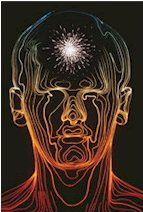 Not one to miss out on the biotech revolution, the US military is considering some radical ideas as it prepares for combat preparedness for the period 2020-2050. In particular, the military is hoping to expand on its idea of 'nonlethal' force and integrate it with the cognitive and behavioural sciences.
Not one to miss out on the biotech revolution, the US military is considering some radical ideas as it prepares for combat preparedness for the period 2020-2050. In particular, the military is hoping to expand on its idea of 'nonlethal' force and integrate it with the cognitive and behavioural sciences.Chief scientists William L. Baker, Eugene J. Bednarz and Robert L. Sierakowski of the Air Force Research Laboratory's Directed Energy Directorate and Munitions Directorate are working on a concept known as "Controlled Personnel Effects." With CPE capability it will be possible to target individuals with nonlethal force and to make selected adversaires think or act according to the military's needs. It is thought that CPE will give rise to the potential to physically influence or incapacitate personnel.
An example of this technology is "Active Denial" in which a nonlethal counterpersonnel millimeter wave system can create the sensation of burning skin to repel an individual or group of people without harm. Also, by studying and modeling the human brain and nervous system, the military hopes to acquire the ability to mentally influence or confuse personnel. Through sensory deception, it may be possible to create synthetic images, or holograms, to confuse an individual's visual sense or confuse his senses of sound, taste, touch, or smell. Essentially, advanced technologies will enable the future soldier to remotely create physical sensations for the enemy, such as pressure or temperature changes.
More invasively, through cognitive engineering, scientists will eventually develop a better understanding of how an individual's cognitive processes affect his decision making processes, namely pattern recognition, visual conditioning, and difference detection. Once understood, military scientists could use these cognitive models to predict a person's behaviour under a variety of conditions with the potential to affect the enemy and his goals using a wide range of personnel effects.
Tags: military technology, cognitive science, neurohacking, emerging technology, active denial, controlled personnel effects.
Latest SentDev Podcast posted
The latest Sentient Developments podcast is now available.
Feed: http://feeds.feedburner.com/PodcastSentDev
Tags: Podcast, Audiocast, Transhumanism, Emerging Technology, Futurism, religion, secularism, politics, islam, augmented reality.
Feed: http://feeds.feedburner.com/PodcastSentDev
Tags: Podcast, Audiocast, Transhumanism, Emerging Technology, Futurism, religion, secularism, politics, islam, augmented reality.
Monday, February 13, 2006
Augmented reality and a point-and-click world
 At the risk of gross understatement, virtual reality offers enormous transformative potential for individuals and society. That being said, VR's little brother, augmented reality (AR), will be no slouch either.
At the risk of gross understatement, virtual reality offers enormous transformative potential for individuals and society. That being said, VR's little brother, augmented reality (AR), will be no slouch either. AR will allow people to perceive the real world with a wide array of add-ons, such as helpful signs, maps, and even filters to screen out unwated parts of the real world (like flashing neon signs and other eye-sores). It will also enable people to interact with their environment in unprecedented ways, particularly in terms of information gathering. Esstentially, AR will apply digital technology to enhance the analog world.
Toronto fyborg, Steve Mann, has done considerable work in this regard. He's envioned an eye-tap device (i.e. a personal imaging system) that will empower future humans (or cyborgs, I suppose) by giving them control over their visual field -- a realm that has been all but monopolized by corporate interests and underfunded municipalities. Mann, who has also referred to AR as 'computer-mediated reality,' has hoped that this technology will develop outside of corporate circles, but it now appears that this opportunity may have been lost.
GeoVector Corporation and CyberMap Japan (AKA Mapion) recently announced the availability of Mapion Local Search (MLS) for mobile phones in Japan.
With MLS, users can walk down the street anywhere in Japan and point at over 700,000 objects such as buildings, shops, restaurants, banks, historical sites and instantly retrieve information on what they are looking at or find what they are looking for just by pointing their phone. Just like one uses a mouse to click on an object on a computer screen and retrieve information, users will be able to "Click on the Real World" using their mobile phone.
Eventually, it is hoped that users will be able to point their mobile phones at restaurants to get reviews, point at billboards and go directly to the advertiser’s mobile site for shopping, point at a movie poster and buy a ticket, and play a game by pointing at your friends.
While the potential for this is huge and virtually unlimited, it looks as though this service will act as yet another delivery mechanism for advertisments and for quicker access to online stores. Unlike Mann's version of AR, GeoVector's AR is not independent, accessible, or subversive.
But given the nature of technological development, the rise of open source, and burgeoning accessibility, I would have to think that Mann's vision for the common man's AR will eventually come to pass.
Tags: augmented reality, steve mann.
Villard & Cook's Infinite Worlds
 Infinite Worlds : An Illustrated Voyage to Planets beyond Our Sun (Hardcover)
Infinite Worlds : An Illustrated Voyage to Planets beyond Our Sun (Hardcover)by Ray Villard, Lynette R. Cook
Book Description:
Merely a decade ago there were no known planets orbiting sunlike stars outside our own solar system. In the past ten years, however, fast-paced developments in astronomy have revealed over 140 extrasolar planets--with more discoveries surely on the way. Though it will be years before we have direct images of these far-flung worlds, this lavishly illustrated book gives us an idea of what they might look like. A fascinating exploration of the cosmos written for a wide audience, Infinite Worlds brings together Lynette Cook's internationally renowned astronomical artwork, the latest and most dramatic images from the world's top observatories, and up-to-the-minute scientific findings on subjects ranging from the big bang and stellar evolution to a possible universe filled with countless planets and life forms.Read Jeff Foust's review in The Space Review.
The newly discovered planets are boggling astronomers' minds with their bizarre characteristics, including an unimagined diversity of sizes and orbits. In Lynette Cook's scientifically based illustrations--many newly created for this book--we glimpse the landscapes and atmospheres that might adorn these planets. Ray Villard's text elegantly describes the state of astronomy today, imagines where it will take us in the coming years, ponders the chances of success for the Search for Extraterrestrial Intelligence (SETI), and explores the survivability of life in an evolving and accelerating universe.
Tags: astronomy, astrobiology.
Faith and the "willful abdication of reason"
 Here in Canada, and I can imagine in other developed countries as well, the combination of growing secularism alongside multicultural tolerance has resulted in a bandying of religious groups who collectively feel threatened, but who also feel empowered by their freedom to express. As a result, a large number of interfaith groups have emerged who are startlingly tolerant of one another.
Here in Canada, and I can imagine in other developed countries as well, the combination of growing secularism alongside multicultural tolerance has resulted in a bandying of religious groups who collectively feel threatened, but who also feel empowered by their freedom to express. As a result, a large number of interfaith groups have emerged who are startlingly tolerant of one another.My guess as to why this is has also to do with the watering-down of strong religious rhetoric. Most religious groups here in the West aren't really interested in battling each other over doctrinal differences. Rather, they're finding that they need to work together in order to survive the secularization of public institutions and of culture itself.
The one trait that binds them together, of course, is faith. In fact, faith is often worn by the devout as a badge of pride, one that gives believers a strong sense of commonality with those of other faiths. Walking around UofT campus, for example, you're likely to see "Faith Matters" posters strewn about.
But as George M. Felis recently noted in a Butterflies and Wheels OpEd, faith is nothing to be proud of. In fact, he argues that it's a moral failing.
For Felis, faith means believing something because one chooses to believe it, without regard to the absence of evidence. But faith is not a mere failure of reason, writes Felis, it is the willful abdication of reason.
"Faith isn't a mistake along the same lines as a logical error such as affirming the consequent," he writes, "It is not simply an oversight of evidence that ought to be under consideration. Faith is the declaration that reason may be all well and good in other areas, but reason ends here where the believer says it does! No argument can conceivably be given for not adhering to the standards of reason on any given subject, because argument itself must adhere to rational standards. Otherwise, it isn't argument - it's shouting, empty noise, full of sound and fury, but signifying nothing."
Felis is obviously spot on. The general public, and especially the media, need to stop praising the virtues of blind faith. Rather, what should be lauded are those individuals who are critical of belief systems and who leave the door open for other metaphysical, spiritual, and existential possibilities.
Thanks to Jeff Patterson of Gravity Lens for passing on the article.
Tags: religion, science and religion, secularism, atheism.
Sunday, February 12, 2006
New Wikipedia article: Postgenderism
 Last week I created a new entry in Wikipedia: postgenderism. I added it mostly because I was surprised to find it absent. The idea of the postgendered posthuman is nothing new, with Donna Haraway's Cyborg Manifesto propelling the concept straight into popular consciousness and the culture wars.
Last week I created a new entry in Wikipedia: postgenderism. I added it mostly because I was surprised to find it absent. The idea of the postgendered posthuman is nothing new, with Donna Haraway's Cyborg Manifesto propelling the concept straight into popular consciousness and the culture wars. That being said, I don't believe Haraway directly articulated 'postgenderism' specifically; she was speaking more of the 'female cyborg' liberated from biological reproduction. The postgenderism that I'm thinking about is more gender neutral with a stronger emphasis on the elimination of not just biological reproduction, but of all gender-specific aspects that differenciate the sexes.
The intro to the Wikipedia piece reads like this:
Postgenderism is a diverse social, political and cultural movement whose adherents affirm the elimination of gender in the human species through the application of advanced biotechnology and assistive reproductive technologies. Advocates of postgenderism argue that the presence of gender roles, social stratification, and cogno-physical disparities and differences are generally to the detriment of individuals and society. Given the radical potential for advanced assistive reproductive options, postgenderists believe that sexual reproduction will eventually become a thing of the past, placing the entire need for gender and gender differences into question.I hope that others contribute to this entry, particularly in adding referrences to those who have worked on this subject and movement.
Tags: transhumanism, social issues, wikipedia, postgenderism, postgender, androgyny, posthumanism, posthuman, gender differences.
Friday, February 10, 2006
Ronald Bailey: Liberation Biology
 From the Website:
From the Website:In his new book, Liberation Biology: The Scientific and Moral Case for the Biotech Revolution, Reason's Ronald Bailey examines the scientific and ethical controversies surrounding everything from stem cell research to therapeutic cloning to longer life spans to genetically modified food. Bailey writes, "The benefits of biotechnology are well known–the cure of diseases and disabilities for millions of sufferers; the production of more nutritious food with less damage to the natural environment; the enhancement of human physical and intellectual capacities—and all can be easily foreseen. It is the alleged dangers of biotechnology that are, in fact, vague, ill defined, and nebulous."
Bailey, whose work was featured in The Best American Science and Nature Writing 2004, makes the case that science can, and will, help us live longer, healthier, and happier lives, without creating human clones or designer plagues. Liberation Biology dispels many myths spread by a small faction that hopes to control medical and scientific research (why we won't be seeing a cloned, half-sheep/half-human creature, for example); demonstrates why scientists and doctors, not politicians, should confront the uncertainties that come with biotechnology in the same way they confronted uncertainties about the ethics of X-rays, birth control pills, bypass surgeries, and in vitro fertilization when they were first used; and why patients and families should ultimately have the freedom of choice to embrace stem cell and biotech benefits or reject them for personal reasons.
Tags: bioethics, transhumanism, futurism, medical technology.
Pulling the Plug on Unwilling Patients
 Reason's science correspondant, Ronald Bailey, has an article out in which he discusses the different approaches lefties and righties have when thinking about 'pulling the plug' on dying patients.
Reason's science correspondant, Ronald Bailey, has an article out in which he discusses the different approaches lefties and righties have when thinking about 'pulling the plug' on dying patients.More specifically, Bailey asks the tough question in regards to pulling the plug on unwilling patients: should the high cost of living affect one's chances of dying?
Bailey is referring to last month's episode at the Baylor Regional Medical Center in Plano, Texas, where medical officials disconnected a dying, uninsured cancer patient, Tirhas Habtegiris, from the ventilator that was keeping her alive.
Habtegiris, a 27-year-old abdominal cancer patient, was conscious and did not wish to be disconnected because she hoped that her mother would arrive from Africa for one last visit before she died. The hospital warned the patient and her family that it would keep her on the ventilator for just 10 more days. Ms. Habtegiris died 16 minutes after the ventilator was shut off on December 14, 2005.
As Bailey notes, the hospital was acting according to a law passed in 1999 that allowed it to discontinue "inappropriate" medical care despite the wishes of a patient or the patient's family.
In regards to the episode's fall-out and ensuing culture war, Bailey writes that his impression of the controversy is that "most left-wingers believe that every conscious patient should have as much medical care as they want regardless of the cost to the rest of us. On the other ideological hand, right-wingers seem confused. As the Terri Schiavo case showed many apparently want to offer unlimited medical care to brain-dead patients whose wishes are unknown or contested by family members. Meanwhile their silence in the Habtegiris case might be construed to mean that it's all right to make hard-headed decisions like denying medical care to conscious patients who are indigent."
Bailey goes on to note the fiscal pressures of keeping patients alive and ultimately concludes that "perhaps it was wrong for Baylor to pull the plug in this instance, but it is clear that in the real world of limited medical resources that the "authorities," whether private or governmental, will unavoidably be making similar life and death decisions in the future."
Tags: bioethics, euthanasia.
Thursday, February 9, 2006
Lynch's Dune: Extended Edition
 An extended version of David Lynch's 1984 version of Dune has been released on DVD. Over 40 minutes of extra footage has been added to the film, bringing the total running time up to 3 hours.
An extended version of David Lynch's 1984 version of Dune has been released on DVD. Over 40 minutes of extra footage has been added to the film, bringing the total running time up to 3 hours.Mark Mortimer's review.
Tags: dune, science fiction, reviews.
Wilsdon: Who would not want to live to be 150?
 James Wilsdon, head of science at the think-tank Demos, has published an article in the Financial Times called "Who would not seize the chance to live to be 150?"
James Wilsdon, head of science at the think-tank Demos, has published an article in the Financial Times called "Who would not seize the chance to live to be 150?" The article promotes their recent book, "Better Humans? The politics of human enhancement and life extension," but Wilsdon also explores the work of biogerontologist Aubrey de Grey.
The article promotes their recent book, "Better Humans? The politics of human enhancement and life extension," but Wilsdon also explores the work of biogerontologist Aubrey de Grey.Wilsdon describes de Grey's work and quotes the usual suspect, Jay Olshansky, for counter-opinion. Frustratingly, Olshansky is actually making a career of pooh-pooh'ing life extension simply due to the fact that he's the go-to guy for a press that is dominated by the need to produce 'balanced' journalism.
The article also describes how the life extension community has naturally intermingled with the transhumanists, of which de Grey claims to be a member. De Grey acknowledged his transhumanist proclivities at TransVision 2004 when we awarded him the WTA's Transhumanist Of The Year award.
Strangely, however, Wilsdon describes Ray Kurzweil as being more extreme than the transhumanists (probably because of his belief in a potential technological singularity and the emergence of post-biological super-intelligent creatures). I find this odd and a bit ironic because most the transhumanists I know, whether they be affiliated with the WTA or not, tend to have even more radical notions of artificial superintelligence and the potential for post-Singularity existence.
I suppose the WTA, with its sensible tone and "Better Than Well" slogan, is starting to effectively come across as a moderate voice for transhumanism, if not downright reasonable, a la the Art Caplan bioethics camp.
As an interesting aside, except for his allegiance to the Extropy Institute (he's on their council of advisors), Kurzweil has never described himself as a transhumanist (at least, not that I've ever heard or read -- please, someone correct me if I'm wrong) -- despite the fact that is exactly what he is. I suppose he wants to retain his creds and doesn't want to come across as being an ideologue or someone who's political or activistic.
Back to Wilson's article, he concludes the way most supporters of transhumanism conclude, with a warning about who will bring and control human enhancement technologies. It's a fair concern, and one that the WTA takes quite seriously -- a point on which it splits with other more libertarian-leaning transhumanist thinkers and camps. All transhumanists are to varying degrees biolibertarians, but by no means are they all social libertarians.
Tags: transhumanism, bioethics, futurism, human enhancement, life extension
Wednesday, February 8, 2006
Demos's open access book on human enhancement
 Demos has published an open access book on issues pertaining to human enhancement.
Demos has published an open access book on issues pertaining to human enhancement.Titled "Better Humans? The politics of human enhancement and life extension," the book contains articles written by a number of leading thinkers in bioethics and futures issues -- including the World Transhumanist Association's Nick Bostrom.
Boook description:
We all share a desire for self-improvement.Whether through education, work, parenthood or adhering to religious or ethical codes, each of us seeks to become a ‘better human’ in a variety of ways. And for some people, more consumerist pursuits hold the key to self-improvement: working out in the gym, wearing makeup, buying new clothes, or indulging in a spot of cosmetic surgery.
But now a new set of possibilities is opening up. Advances in biotechnology, neuroscience, computing and nanotechnology mean that we are in the early stages of a period of huge technological potential. Within the next 30 years, it may become commonplace to alter the genetic make-up of our children, to insert artificial implants into our bodies, or to radically extend life expectancy.
This collection of essays by leading scientists and commentators explores the implications of human enhancement technologies and asks how citizens and policy-makers should respond.
 You can download the individual essays:
You can download the individual essays:01 - Stronger, longer, smarter, faster - Paul Miller and James Wilsdon
02 - Is it wrong to try to improve human nature? - Arthur Caplan
03 - Welcome to a world of exponential change - Nick Bostrom
04 - The mand who wants to live forever - Paul Miller and James Wilsdon
05 - The transhumanists as tribe - Greg Klerkx
06 - Brain gain - Steven Rose
07 - The cognition-enhanced classroom - Danielle Turner and Barbara Sahakian
08 - Better by design - Sarah Franklin
09 - More life - Jon Turney
10 - Nip/Tuck nation - Decca Aitkenhead
11 - The perfect crime - Rachel Hurst
12 - The unenhanced underclass - Gregor Wolbring
13 - Does smarter mean happier? - Raj Persaud
Tags: transhumanism, bioethics, futurism, human enhancement.
SETI: Imagining alien organisms
 There's a neat article in this month's Wired about SETI's imaginings of other habitable planets and the possible organisms that might crawl on their surfaces:
There's a neat article in this month's Wired about SETI's imaginings of other habitable planets and the possible organisms that might crawl on their surfaces:On Aurelia, an Earth-sized planet half shrouded in perpetual darkness, vast floodplains give way to groves of treelike stinger fans that use ambulatory roots to creep across the muddy surface. On Blue Moon, a lunar orb in an adjacent solar system light-years from Aurelia, winged skywhales gulp aerial plankton suspended in the dense atmosphere, while balloon plants float beneath the canopies of massive pagoda tree forests, buoyed by hydrogen gas-filled membranes like miniature Hindenburgs.SETI wanted to make the worlds as realistic as possible, so they ran detailed climate simulations on a desktop Linux box, allowing the scientists to observe the consequences on habitability of a range of complex atmospheric variables like thermal circulation and precipitation levels.
SETI also applied the principles of natural selection and adaptation to populate the planets, determining creature leg lengths and wingspans using biomechanics algorithms. They established vegetation height and characteristics according to factors like available light and the amount of carbon dioxide in the atmosphere.
 While I laud their efforts, I also look at these renderings with a grain of salt (there are more images at the Wired article). While the science seems relatively sound, there appears to be a dash of whimsey associated with each creature.
While I laud their efforts, I also look at these renderings with a grain of salt (there are more images at the Wired article). While the science seems relatively sound, there appears to be a dash of whimsey associated with each creature. The kite creatures, for example, seem like far too easy prey, and the flying whales are a bit much.
Whales developed on Earth out of such environmental moulders as our particular level of gravity and how that relates to hydrodynamics and size. Given a low gravity planet, I'm dubious that whales would evolve in the first place, let alone evolve for flight. Not too many creatures have evolved from marine to flying animal -- it doesn't seem like a very good adaptation.
I'm also wary of seeing astrobiologists stray too far outside our own planetary example. When it comes to the expression of DNA, I guess I lack imagination -- but I have a suspicion that the conditions for the existence of complex life in the Universe are incredibly stringent.
It's been said that we live on the Goldilocks planet and it is just "right for life." Consequently, we need to be Copernican in our attitudes and assume that we're not just average or unordinary, but hyper-typical.
But that's why we have astrobiologists who have more imagination to prove me wrong.
Tags: Life on Other Planets, Astrobiology, SETI.
Tuesday, February 7, 2006
The science of Battlestar Galactica
 Okay, I have to admit that I'm a Battlestar Galactica junky. For an American TV show, it's not half bad and damn entertaining. Sure, it has some 'eyes roll to the back of your head' moments, but then again, as a show that attempts to mirror current social and geopolitical issues in the United States, along with obnoxious American attitudes and sentiments, one rolls their eyes to the back of their heads when they read much of today's news.
Okay, I have to admit that I'm a Battlestar Galactica junky. For an American TV show, it's not half bad and damn entertaining. Sure, it has some 'eyes roll to the back of your head' moments, but then again, as a show that attempts to mirror current social and geopolitical issues in the United States, along with obnoxious American attitudes and sentiments, one rolls their eyes to the back of their heads when they read much of today's news.Galactic-scale cheese and corn aside, the show isn't entirely insulting to one's intelligence. The writing, drama, and characters are pretty solid and it has a "West Wing" set in space melodramatic feel. You really empathize with the characters and their predicament; these people have just been put through a holocaust and their would-be destroyers are still hot on their tail. Needless to say, tempers and prejudices run very high.
Oh, and the cylons are seriously bad-ass -- both the robotic ones and the cyborgs. In a neat bit of sci-fi writing, when a cylon dies their memories are immediately uploaded to central computer on board a "resurrection ship." The memories are then relayed to a cylon clone who is in turn sent out to re-terrorize the crew of the Galactica. I suppose it's how satan would manage reincarnation if he had the opportunity.
 While not quite at the level of hard science fiction, the science isn't terrible. In fact, the writers are going out of their way to make this show realistic -- unlike its campy 1970s predecessor. A recent SciFi.com article, Reach for a Battlestar [link discovered on Gravity Lens], explores this very issue, sorting out the pseudoscience from the real science. The article covers issues such as the movement of spaceships in space, the sounds of laser fire, and uploaded memories.
While not quite at the level of hard science fiction, the science isn't terrible. In fact, the writers are going out of their way to make this show realistic -- unlike its campy 1970s predecessor. A recent SciFi.com article, Reach for a Battlestar [link discovered on Gravity Lens], explores this very issue, sorting out the pseudoscience from the real science. The article covers issues such as the movement of spaceships in space, the sounds of laser fire, and uploaded memories. Much of the show's success, I believe, is due to the fact that nature abhors a vacuum and Battlestar Galactica has beautifully filled the ecological niche left absent by Star Trek. I bet a quick survey of Battlestar fans would unveil a slew of Trekies.
Still, it's very good television space opera sci-fi and I recommend it for those who enjoy that kind of entertainment. Like me.
Tags: battlestar galactica, reviews, science fiction, television.
Monday, February 6, 2006
West Coast singularitarians on the prowl
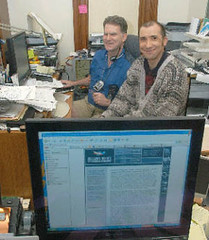 Keith Norbury of the Victoria News in British Columbia has published an article about Canadian singularitarians David Coombes and Michael Roy Ames.
Keith Norbury of the Victoria News in British Columbia has published an article about Canadian singularitarians David Coombes and Michael Roy Ames.The article describes their work as the only current Canadian chapter of the Singularity Institute for Artificial Intelligence, which is "devoted to promoting the creation of friendly, superhuman intelligence for the benefit of humanity." Norbury provides a decent summary of issues pertaining to a potential technological singularity, the insights of Ray Kurzweil, and the potential implications of artificial superintelligence -- including potentials for the threat of annihilation or the bliss of infinite lifespans.
Coombes and Ames are portrayed fairly, although Norbury does note, quite accurately in my opinion, that there are parallels between singularitarian and religion. Some have referred to the singularitarity, for example, as "Rapture of the Nerds."
The Canadian duo sometimes sound a bit much, like when Coombes says, "I am doing this to solve the world's problems. This is an important thing to do," or when he says "I think it's pretty obvious something is going to happen. I read a lot of science fiction and technical science magazines like Discover and Scientific American," -- hardly your preeminent academic journals.
That being said, it's hard to deny the work and prognostications of singularitarians; there are a number of intriguing and even eerie indicators that show something's going on with exponential accelerating change.
"By its definition, the Singularity is beyond our comprehension," writes Norbury, "but Kurzweil envisions a world where reality and virtual reality become indistinguishable. Ultimately this consciousness spreads across the cosmos at nearly the speed of light - or even faster. The runaway changes leading to that aren't yet noticeable because in its initial stages an exponential graph appears quite flat. Only at the "knee of the curve" does it begin to veer sharply upward. We're at the knee now, Kurzweil says."
All-in-all, an interesting article about a pair of interesting guys working at the grassroots level to bring up public awareness on this important issue.
Tags: singularity, transhumanism, artificial superintelligence.
Nudging those pesky NEO's out of the way
 When considering ways of preventing a near-earth object (NEO) from striking the Earth, it's all to easy to suggest that we blow it out of the sky with nukes or other powerful weapons.
When considering ways of preventing a near-earth object (NEO) from striking the Earth, it's all to easy to suggest that we blow it out of the sky with nukes or other powerful weapons. However, this is not the most elegant or safest of solutions, primarily for the reason that a plethora of much smaller NEO's are created in the process, arguably creating a whole slew of new threats.
Rather, it's been thought that the key to managing threatening NEO's, such as asteroid Apophis (which has a disturbingly close chance of hitting us in 2036), is to simply brush them aside and change their trajectory.
Along these lines, a pair of NASA astronauts, Edward Lu and Stanley Love, have proposed that a 65-foot-long space "tractor" be deployed to hover above an asteroid and use its gravitational force to "tug" the NEO out of harm's way.
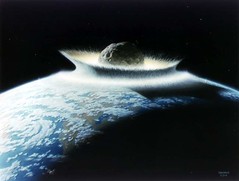 Their plan calls for the spacecraft, what they call the "gravitational tractor," to hover near the asteroid for a period of several months or years. The small gravitational force exerted on the asteroid by the vehicle would be enough to move the NEO into a slightly different orbit. Astonisingly, the force required could be as little as a quarter of a pound.
Their plan calls for the spacecraft, what they call the "gravitational tractor," to hover near the asteroid for a period of several months or years. The small gravitational force exerted on the asteroid by the vehicle would be enough to move the NEO into a slightly different orbit. Astonisingly, the force required could be as little as a quarter of a pound.What would it take to get Apophis out of the way? This nasty NEO is between 1,000 and 1,300 feet long and weighs about 50 million tons. Love and Lu argue that if the grav-tractor was sent up 10 years before potential impact, the job would require a one-ton spacecraft to make the necessary small adjustment in Apophis’s trajectory.
Piece of cake.
Now we just need to make sure we do it. I can just see us around the year 2032 thinking, jeez, maybe we should've done something about this a couple of years ago....
Tags: Disasters, Near Earth Objects, Catastrophe, Existential Risks, disaster prevention.
Wednesday, February 1, 2006
Future terror: neurohacking
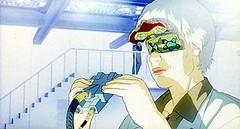 In the 1995 anime sci-fi classic, Ghost in the Shell, a futuristic world was envisioned in which cybernetic individuals routinely operate in the virtual world as easily as in the real one. Transhuman cybernetic minds are inextricably connected to the cyber-realm, leaving them vulnerable to attacks.
In the 1995 anime sci-fi classic, Ghost in the Shell, a futuristic world was envisioned in which cybernetic individuals routinely operate in the virtual world as easily as in the real one. Transhuman cybernetic minds are inextricably connected to the cyber-realm, leaving them vulnerable to attacks.In this projected future people are subjected to 'ghost hacking' in which their minds are taken over by computer hackers without their knowing it. Their 'ghost' or essence, or soul, or self, or whatever descriptor you want to give for self-identity, is manipulated and controlled from a remote source.
As disturbing as this sounds, it's not beyond the realm of plausibility. When considering the Church-Turing thesis of computational compatability, and given recent insight into cognitive computationalism (or functionalism), one can make the assumption that future human minds will be indelibly linked to extraneous computer systems.
And as a frightening precursor to 'ghost hacking', also known as neurohacking, a recent article in Technology Review reveals that the first generation of invasive neurohacking may be only years away.
In her article, titled "Could Terrorists Hijack Your Brain?" Emily Singer reports on how security experts are warning that we need to prepare for a much broader spectrum of potential bioterror agents -- this according to a report released this week by the Washington, DC-based National Academies.
While most bioweapons research is focused on the usual suspects, namely such agents as anthrax and smallpox, it is now though that emerging technologies in biotechnology and the life sciences could be usurped to take control of genes, immune systems, and even brains.
Terrorists, or even state-actors for that matter, could also co-opt relatively new technologies, such as synthetic biology (which aims to build organisms that can detect or produce chemicals or perform other functions) or RNA interference (a technique that allows scientists to easily control gene expression).
There is also concern about the potential of bioregulators -- small, biologically active organic compounds that can regulate different systems in the body. Newer technologies such as targeted delivery methods that zero in on the immune or neuroendocrine systems could make it easier to use bioregulators in evil ways.
Such is the double-edged sword of technological development. For each advancement, someone can twist it for self-serving and nefarious purposes. Consequently, in order to prepare for the ever-changing "threat spectrum," the advisors recommend that technologies with dual-use potential -- those that can be used to either help or harm humanity -- be continually reassessed to take account of rapid advances in biotechnology.
Additionally, it is suggested that a scientific advisory board be developed to assist the national security community and to ensure that teams monitoring these threats have the most up-to-date scientific expertise. It was also advised that public health infrastructures be strengthened and that incentives be put into place for the creation of broadly active vaccines and other products that can protect against diverse agents.
 "It's like the transition from trench warfare to mobilized warfare between World War I and World War II," notes one of the report authors. "How do we begin to defend ourselves against that dynamic threat landscape? How do we adapt our health, medical, and biodefense systems to respond to that?"
"It's like the transition from trench warfare to mobilized warfare between World War I and World War II," notes one of the report authors. "How do we begin to defend ourselves against that dynamic threat landscape? How do we adapt our health, medical, and biodefense systems to respond to that?"Interestingly, the advisors also endorsed an open exchange of information in the life sciences as much as possible, emphasizing that the best means of protecting against future threats is further advances in technology.
So, are we indelibly headed for a Ghost in the Shell like future? Quite possibly yes, but it appears that we may have the safeguards, firewalls, and prophylaxis in place to deal with the problems as they arise.
As a final aside, humans have had to deal with 'neurohacking' for quite some time now, but not in such invasive ways. Ever since propaganda was developed, people have had their minds influenced by external sources. And memes themselves, whether they be autonomous or created and directed by individuals or groups, are impacting on their hosts, directing the human sense of self and how decisions are forumlated.
It looks, however, that keeping control of our minds is about to get harder by a significant degree of magnitude.
Tags: terrorism, neurohacking, bioweapons, transhumanism, disaster prevention.
Astrobio: Relentless Evolution [2002]
Back in 2002, Astrobiology assembled some prominent thinkers to discuss the Fermi Paradox. The group consisted of Michael Meyer, Chris McKay, David Grinspoon, Frank Drake and Donald Brownlee.
Their discussion is a must read for anyone interested in the Fermi Paradox and the potential evolution of advanced intelligent life -- including the possibilities of space travel and the attainment of immortality.

Debate moderator Michael Meyer, the Senior Scientist for astrobiology at NASA Headquarters and Program Scientist for the Mars 2001 Odyssey Mission.

Frank Drake, Chairman of the Board of Trustees of the SETI Institute, and Professor of Astronomy and Astrophysics at the University of California at Santa Cruz.

Christopher McKay, planetary scientist with the Space Science Division of NASA Ames Research Center.

Donald Brownlee, co-author of "Rare Earth," and Professor of Astronomy of the University of Washington in Seattle.

David Grinspoon, Principal Scientist in the Department of Space Studies, Southwest Research Institute in Boulder, Colorado, and author of the book "Lonely Planets: The Natural Philosophy of Alien Life".
Here's what Frank Drake had to say:
Tags: Fermi Paradox, Life on Other Planets, Astrobiology, SETI, astrosociobiology, transhumanism, immortality.
Their discussion is a must read for anyone interested in the Fermi Paradox and the potential evolution of advanced intelligent life -- including the possibilities of space travel and the attainment of immortality.





Here's what Frank Drake had to say:
Every discussion of alien intelligence assumes that they will come visit us. But the expense and danger of space travel are formidable. A strong reason why such enterprises are not carried out may be that radio communication works so much better, is far cheaper, and you get your answers at the speed of light.Read the entire discussion.
Any reasonable transport of creatures across space calls for travel speeds that are a substantial fraction of the speed of light, otherwise it takes too long to go even to the nearest stars. But this exposes the spacecraft to serious hazards. Probably the most serious is the potential for collision with debris -- and we are learning that space is full of debris. At relativistic speeds, even a collision with a particle of a few grams results in something close in energy to a nuclear bomb blast. Not good news for the space travelers.
Also the energy requirements are ridiculous, at least to us. To send a spacecraft the size of a small airliner at one-tenth the speed of light requires as much energy as the US now produces in more than a hundred years. And that just gets you someplace - it doesn't provide for a landing or a return home. To put it another way, it takes 10 million times as much energy to move a small space colony to another star as it takes to establish the same colony in the home system. And there is plenty of room at home. It is easily calculated that the energy of the sun is enough to sustain more than ten thousand billion billion humans. That seems like enough. Why go to the great expense and danger of going to other stars? Truly intelligent life would laugh at the idea. The only ones who might try are the dumb ones, and they don't know how.
Tags: Fermi Paradox, Life on Other Planets, Astrobiology, SETI, astrosociobiology, transhumanism, immortality.
Subscribe to:
Posts (Atom)




